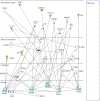Cytokinome profile evaluation in patients with hepatitis C virus infection
- PMID: 25071319
- PMCID: PMC4110556
- DOI: 10.3748/wjg.v20.i28.9261
Cytokinome profile evaluation in patients with hepatitis C virus infection
Abstract
The ''omics sciences'' (genomics, transcriptomics, proteomics) are often used to study living organisms as a whole system by evaluating the complex expression patterns of genes, miRNA, proteins, and metabolites. This study aimed, through bioinformatics and systems biology, to decipher the cytokinome profile in the evolution of inflammatory processes leading to cancer. The cytokinome was defined as the totality of cytokines and their interactions in and around biological cells. The system biology approach would provide a better understanding of the complex interaction network of cytokines, especially in cancer patients. Acquired knowledge would enable health providers with tools to evaluate disease onset through progression as well as identifying innovative therapeutic strategies. Understanding the role each cytokine plays in the metabolic network is of great importance. This paper reviews our group's ''omics'' work. In particular, it addresses the role cytokines play in liver disease in six different scenarios. The first is the role the cytokines play in chronic inflammatory diseases and cancers. The second is the significance of the cytokinome profile. The third is the role of liver cirrhosis as an inflammatory disease. The fourth is the comparison of cytokine levels evaluated in patients with chronic hepatitis C virus (HCV) or with HCV-related cirrhosis. The fifth is the comparison of cytokine levels evaluated in patients with HCV-related cirrhosis in the presence and absence of type 2 diabetes. And lastly, we present a comparison of cytokine levels evaluated in patients with HCV-related cirrhosis in the presence and absence of hepatocellular carcinoma.
Keywords: Cirrhosis; Cytokinome; Hepatitis C virus; Hepatocellular carcinoma; Interactome; Systems biology; Type 2 diabetes.
Figures



References
-
- Lu H, Ouyang W, Huang C. Inflammation, a key event in cancer development. Mol Cancer Res. 2006;4:221–233. - PubMed
-
- Read SA, Douglas MW. Virus induced inflammation and cancer development. Cancer Lett. 2014;345:174–181. - PubMed
-
- Macarthur M, Hold GL, El-Omar EM. Inflammation and Cancer II. Role of chronic inflammation and cytokine gene polymorphisms in the pathogenesis of gastrointestinal malignancy. Am J Physiol Gastrointest Liver Physiol. 2004;286:G515–G520. - PubMed
Publication types
MeSH terms
Substances
LinkOut - more resources
Full Text Sources
Other Literature Sources

